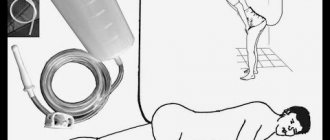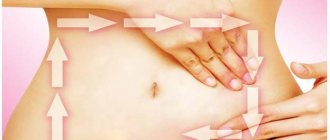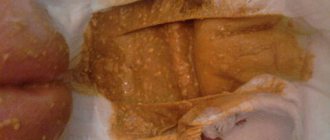Quite often, babies suffer from intestinal colic in the first months of life (here is a detailed article). As a rule, babies who are not yet three months old suffer from this problem; colic often begins to bother them, starting from the second week of life. In order to cope with the problem, various methods and means are recommended, including medications, placing a child in an acute period of colic in a warm bath. One of the most effective ways to help a newborn baby with colic is massage.
Why do you need a massage?
Newborn babies often worry and cry. It is not easy to calm such a baby, because the reason for his crying is not a whim, but painful sensations in the tummy that occur with colic, constipation, accumulation of gas in the intestines (we recommend reading: what is the best choice for colic and gas in the stomach in newborns?).
READ IN DETAIL: treatment of colic and gas in newborns
Tummy massage is one of the ways to help a baby. It is simple, does not require special skills and, as they say, is always at hand. A mother can massage her baby’s belly not only during exacerbations, but also to prevent the accumulation of gases in the intestines. Light hand movements help gas bubbles move through the intestines and come out. The spasms are relieved and the child feels better.
For preventive purposes, you can massage your baby’s tummy approximately 6 times a day. You should also know that you should not do this immediately after feeding - you need to wait 30-40 minutes for the food to be absorbed, otherwise you can provoke vomiting.
If you massage regularly, several times a day, you can ensure that attacks of colic will occur much less frequently and will not be as severe. This will improve the child’s general condition, he will be in a great mood and sleep better.
How to eliminate unpleasant symptoms
If bloating, colic and constipation in a baby do not go away for several days despite all efforts, you should consult a doctor. But most often the mother can cope with them on her own.
It is enough to take some measures:
- do not eat foods that cause gas formation and constipation;
- Before each feeding, place the baby on his tummy on a hard surface;
- hold the baby correctly during feeding;
- after feeding, hold the baby upright until he burps;
- calm the baby by holding him close to your body and rocking him;
- put a warm, freshly ironed diaper on the baby’s tummy;
- when artificial feeding, replace the formula;
- put the baby to the breast more often;
- in case of constipation on artificial feeding, between feedings, give the baby unboiled baby water in the same volume as the food;
- use looser diapers.
One of the most effective ways to eliminate discomfort due to improper digestion in a baby is tummy massage.
How to prepare for a massage?
Before you start the massage, you need to prepare a few things. For the procedure you will need:
- If the room is cool, you need to turn on the heater. The room temperature should be warm.
- Wash your hands well with soap.
- Get a spare diaper.
- Undress the child.
- Heat another diaper with an iron or on a radiator, and then apply it to the baby’s tummy.
Any auxiliary products - massage oil or cream - are not needed. Massage for a newborn is done with dry, clean hands.
READ ALSO: how to massage a newborn from 0 and older?
It is also necessary to choose a suitable location. You can sit on a changing table, sofa, bed. The surface must be horizontal and level. If it is a sofa, it should not be hard, and the bed should not sink: an uneven or too soft surface will significantly complicate your actions, and the baby will be uncomfortable on one that is too hard. Some mothers simply hold the baby on their lap, but this is not comfortable for everyone. Besides, not every child will like it.
A second diaper is needed in case the massage procedure will promote not only the passage of gas from the intestines, but also bowel movements (if the baby was constipated). In any case, the colic will decrease or go away completely, the spasms will subside, and the child will feel better, since the stomach will no longer bother him.
READ ALSO: how to get rid of gas in a 1 month old baby if he screams a lot?
Never forget about the psychological attitude - constantly talk to the child and smile, accompany the massage with nursery rhymes (more details in the article: video lessons on massage for a 4-month-old baby). Even if during a severe exacerbation the baby screams and cries, accompany your actions with a conversation in a calm tone. A child should always feel his mother’s love and affection - this will also have a beneficial effect on his condition.
General recommendations
How to do the procedure correctly to increase the effectiveness of massage techniques? Several rules must be followed:
- Carry out the procedure on an empty stomach. For systematic colic, it is better to massage 30 minutes before feeding the baby, or wait 1.5 hours after;
- You need to massage for about 5-7 minutes. The first procedures can be made shorter to make it easier for the child to get used to the new activity;
- Before stroking, it is better to warm the baby’s tummy to relax the muscles;
- Do not use cream or special oil to massage your tummy. Contact with the baby's skin increases, leading to increased effort during the procedure. Wet hands can be treated with powder;
- Follow the directional rule - movements are carried out clockwise. They must correspond to the location of the intestines so that gases escape, relieving discomfort;
- Monitor the baby's behavior. If he calms down, it means the massage is being performed correctly. If crying and anxiety increase, the procedure should be stopped and the child should be shown to a pediatrician;
- Maintain a favorable atmosphere, talk to the baby, hum a song, smile. Can be accompanied by calm, quiet music;
- The procedure begins and ends with light massage strokes.
A properly performed abdominal massage for colic in a child helps relieve symptoms, but does not affect the root cause. In case of systematic digestive disorders, you should consult a specialist. Sometimes it is enough to adjust the baby’s diet, but drug therapy may also be necessary.
Tummy massage
It is correct to start a tummy massage for a newborn with warming; Even if you have heated the diaper and applied it, then hold your palms briefly on the baby’s stomach. This will relax the abdominal muscles, partially relieve spasms and have a beneficial effect on the nervous system.
READ ALSO: how to properly attach a newborn to the breast: video of infant feeding techniques
Then you can gradually begin light circular stroking. Moreover, clockwise movements stimulate the digestion process, and in the opposite direction they have a relaxing effect; Therefore, if you fed your baby some time ago, stroke his tummy in a clockwise direction, and if it’s time for daytime or nighttime sleep, counterclockwise. Movements must be very careful. Be careful that your hands do not touch the navel - if it has not yet completely healed, you can cause additional pain to the baby. Stroking alternates with pressure, which intensifies slightly on the sides.
If a child has an attack and the colic intensifies, you need to take turns working on the area first on the left side and then on the right. Smoothly move your hand from the navel to the thigh. Remember that light movements should be replaced by intense ones.
Next, flexion and extension of the legs are performed. When the baby is lying on his back, his legs need to be carefully bent at the knees and pulled up to the chest; you can straighten one or the other in turn, then both together. It is also possible to raise straight legs - at this age the child has excellent plasticity, so such gymnastics always brings a lot of pleasure.
READ ALSO: gymnastics on fitball for infants
The “Bicycle” exercise is very effective, which is first done by a mother to a newborn baby, and then children at any age love to do it on their own. The child’s legs need not only to be bent and pulled towards the chest, but also to make rotational movements that imitate riding a bicycle forward. Usually, if you massage not during an attack, but to prevent it, kids really like this exercise. “Bicycle” stimulates the digestion process, strengthens the abdominal muscles and adds an element of play to the massage.
Exercise "Frog". The child's legs need to be bent so that the feet are connected. Then you need to try to get your heels to touch your buttocks. During the exercise, the baby should be supported by the lower back with one hand. You can simply bend and unbend the legs one by one and at the same time.
Abdominal massage for a newborn with colic
When your baby suffers from colic, it causes serious discomfort for both you and him. The baby cries in pain and cannot always cope with this phenomenon on his own. You can help him get rid of excess gas in the intestines, and also start his normal functioning with several types of tummy massage.
- Bike. Place your baby on his back, gently grab his shins and bend each leg one at a time, pressing it tightly against his tummy. Then straighten the leg and do this procedure with the other leg. It is important to press the legs against the tummy with moderate force - this procedure should be pleasant for the child and not cause him pain or discomfort. If your child is crying, try to calm him down first, and then repeat the procedure in a playful way, saying rhymes or songs. The massage should be carried out in a warm room, because the baby should not freeze.
- Pressing both legs to the stomach. Grab your newborn by the shins, just below the knee. Bend both legs and press them towards your stomach. With your legs pressed to your tummy, perform movements in the shape of a semicircle from the middle of the belly to its sides. At the same time, it is important that the child massages his stomach with his own legs. After several rotational movements, do the same, but in the opposite direction. This type of massage is most popular among young mothers because it is safe and very effective.
- Massage with fingers. Place the naked baby on his back, and lubricate his tummy and your hands with warm baby oil. With two fingers tightly clenched (index and middle) and gentle massaging movements, lightly press on the tummy from the bottom left. Then move up and to the right clockwise, thus describing a large semicircle. Next, place your fingers on the lower left side of your tummy, a little closer to the center than the first time, and describe a smaller semicircle. Repeat this procedure a third time, moving your hands almost to the center of your tummy. Always end your massage movements in the lower abdomen, in the area of the rectum.
- Ball massage. Place your baby's tummy on a large bouncy ball. Carefully supporting him, gently roll the baby on the ball so that the ball presses on the baby's tummy, massaging it. Infants really like this type of massage - it is fun and effectively helps remove excess gas that causes colic.
Placing baby on tummy
This exercise also very well helps the child get rid of accumulated gases and performs another additional function - it helps strengthen the neck muscles, which is especially useful when the newborn baby has not yet learned to hold his head up on his own. You also need to place the baby on his stomach several times during the day. This will be a good prevention of constipation.
READ ALSO: Why does a newborn baby groan and what to do in this case?
After turning the baby over, lightly stroke the back and sides, especially over the pelvic bones. Hand movements should be directed from the stomach to the lower back. Stroking can also be alternated with gentle pressure.
The “House” exercise is good for getting rid of gases and stimulating digestion. Place your palms on the child's lower back, and then make sweeping movements along the oblique abdominal muscles, and then join your hands above the navel. “House” can be repeated several times a day.
Massage exercises can be varied by swinging on a large ball (fitball for infants). It is better to choose a smooth ball, cover it with a diaper and place the baby on it, belly down. Smooth rocking movements will not only perform a kind of tummy massage, but also train the vestibular apparatus, as well as strengthen the nervous system. The ball, however, should be handled very carefully, since exercises on it require some getting used to.
Massage for constipation in infants - effective techniques
The imperfection of the digestive system in newborns leads to problems with stool.
There is a special stimulating massage technique that allows you to restore normal functioning of the gastrointestinal tract in children.
There should be no contraindications, and you should definitely consult a pediatrician. Next, we will consider in more detail how to properly massage for constipation in a baby.
Preparing for a massage
Before giving a massage to a child who is constipated, be sure to carefully prepare.
So, let's stick to the following simple tips:
- In order to stimulate the stomach, it is recommended to massage the stomach several times during the day. Only regular massage will allow you to get a positive result.
- In order not to injure the delicate baby skin, it is recommended to trim your nails and be sure to wash your hands before the massage.
- You can use special massage oil or baby cream.
- To get rid of excess gas in the stomach, it is recommended to hold the baby in an upright position.
- The room should be warm.
- Massage can be done only between meals so that the stomach is empty.
- We select a hard surface, for example, a table for changing the baby.
- The baby must be in a good mood to get the maximum benefit from the massage.
Causes of constipation in newborn infants
In an infant, constipation may occur for the following reasons:
- Imperfection of the digestive system. The stomach simply cannot cope with the digestive processes, which leads to stagnation in the colon.
- Introduction of a new product into the daily diet. The body gets acquainted with new food and needs more time to adapt.
- Long-term drug treatment, which leads to dysbiosis.
- Lack of fluid in the body leads to hardening of stool.
- Sedentary lifestyle. In this case, massage will help a newborn with constipation.
Caution: contraindications
Abdominal massage for a baby with constipation is prohibited in the following cases:
- If, when you press on the stomach, the child begins to scream and cry.
- With very tense abdominal muscles.
- If constipation is accompanied by an increase in body temperature.
- General weakness of the body.
- Allergic reactions and damage to the skin of the abdomen.
Preparing the child
Any manipulations can be done only on an empty stomach. It is better to wait two hours after eating and start the massage. In order for all gases to escape from the abdomen, it is recommended to hold the child in an upright position. You can massage on a hard surface to fix the baby in the correct position.
Techniques
Before performing a massage for constipation in newborns, it is imperative to prepare a hard surface.
- We undress the child down to the diaper and place him on his back.
- Next we take a special massage oil. In this case, the child may experience an allergic reaction. To check this, it is recommended to apply a few drops of oil to the child’s feet and wait a few minutes.
- If everything is fine, then the oil can be applied to the palms and belly of the child.
- Next, starting from the bottom of the chest, draw a vertical line of palms through the navel to the beginning of the diaper.
- From left to right, we draw another line through the navel.
- Ultimately, the baby's belly is roughly divided into four squares.
- It is recommended to use a diagram of the child's digestive system to accurately locate the internal organs.
- We do the massage with two fingers, starting from the upper left square. Draw small spirals with your fingers on the baby's belly.
- We do light strokes clockwise. The main thing is that the baby is not in pain. We monitor the baby's reaction. You should not massage when the child is crying or screaming.
- From the right square we gradually move to the left. Next we move to the lower abdomen. At the same time, we continuously make small circles with two fingers.
- We gradually expand the circle, moving from right to left.
- Ultimately, you need to go to the outer border of the abdomen, where the large intestine is located.
- We take some more oil and do a few abdominal compressions. We move from the sides to the central part.
- From the upper part through the entire stomach we do several deep strokes.
Regular abdominal massage helps with colic, constipation, increased gas formation and bloating.
Source: https://lechenie-zapora.ru/lechenie/massazh-pri-zapore-u-grudnichka
Advice from a pediatrician
To empty the baby’s intestines, the baby must be placed on his stomach before feeding, with his bent legs bent under him. It is this position that facilitates the removal of gases.
After feeding, hold the baby in an upright position for a sufficient time so that the air trapped during feeding is released from the stomach.
In humans, the so-called intestinal microflora lives in the large intestine, which is involved in the process of digesting food. These are microorganisms beneficial to humans. Without them, normal digestion is impossible.
In a little person, this microflora is not yet sufficiently formed. An imbalance in the intestinal microflora leads to fermentation in the intestines and, as a result, increased gas formation.
Symptoms
To understand that the baby’s anxiety is associated precisely with discomfort in the intestines, you need to know the symptoms of intestinal colic. Typically, infant colic begins suddenly during or shortly after feeding. The child screams loudly, worries, strains, grunts, and presses his legs to his tummy.
The tummy is swollen, you can hear the sounds of liquid transfusion from a distance, and with your palm you can feel the movement of air through the intestines. At this time, practically nothing brings relief to the baby. Intestinal colic ends as suddenly as it begins.
One of the effective ways to help babies with colic is tummy massage. It can be used during an attack of intestinal colic or for its prevention.
Carefully! Contraindications!
Despite its effectiveness, abdominal massage for colic cannot always be used. This cannot be done if there are symptoms that indicate intestinal obstruction, hernia, etc.
You should call a doctor if you have the following symptoms:
- the tummy is swollen asymmetrically;
- in one place of the abdomen you can feel pronounced peristalsis;
- gases and bowel movements were absent for a long time;
- between attacks the baby remains lethargic, eats poorly and has difficulty falling asleep;
- the body temperature has risen or there are symptoms of a cold or ARVI;
- traces of blood are visible in the stool;
- the pain does not go away for a long time, despite all the measures taken.
You cannot massage against colic if there are any injuries, wounds or abrasions on the baby’s tummy, as well as rashes.
You can only use some techniques that do not involve rubbing your palms on the skin. You should not resort to massage techniques if the umbilical wound has not yet healed.
Now you know how to properly massage your tummy against colic. The simple techniques described in the article will help relieve your baby of pain associated with the intestines adapting to a new way of eating. If you do not know how to massage properly, consult a pediatrician who can “put” your hand on you and explain how to do the basic movements.
- You should not massage the abdomen on a full stomach. It is better to carry out the procedure before meals or an hour and a half after it.
- Do not apply any active pressure in the area of the child’s liver and genitals.
- Don't get carried away! Massage for newborns should not exceed 5-6 minutes of active action.
- Diathesis is not a direct contraindication, but during the acute phase it is better for infants to avoid abdominal massage.
- But for heart and infectious diseases, blood diseases, as well as umbilical hernia - no amateur activity! In this case, only a specialist should perform the correct massage.
Causes of colic in a baby
The main cause of intestinal colic is considered to be the immaturity of the newborn's enzymatic system.
Enzymes are substances that break down food in the stomach and intestines. The newborn does not produce enough enzymes. Therefore, food digestion occurs abnormally, with the release of large amounts of gases. Especially if the child is fed food that is inappropriate for his age. Overfeeding a child can lead to intestinal colic. There are simply not enough enzymes to digest large amounts of food. Food undergoes fermentation. During fermentation, many gases are released - carbon dioxide, hydrogen sulfide. Gases form bubbles, stretch the baby’s intestinal walls and cause severe pain.
Colic can be caused by incorrect positioning of the baby during feeding, when the baby takes in a lot of air with food.
Massage. Mom's hands to help with colic
Perhaps the most common problem for young parents is colic in the child. Anxiety in the first months of life, high-pitched crying, pressing of the legs towards the tummy, frequency of occurrence and relief after the passage of gases are the main manifestations of this condition.
Intestinal colic is not dangerous, but very painful. To help the child, medications, warming the tummy, changing body position, a gas tube, some exercises and tummy massage are used.
In the animal world, mothers lick their babies. Human hands can be much more effective in relieving a child of colic. When and how to massage the abdomen of a newborn?











